A Meditation on the State of Diversity in The American Theatre by a Straight White Man
Earlier this year a metaphorical bomb went off at The Classic Stage Company when Tonya Pinkins left the titular role in Brian Kulick’s production of Mother Courage still in previews. In a public statement explaining why she left, Pinkins cited that her “perspective as a black women was dismissed.” It was a widely reported, rare public airing of a dispute between a leading lady and a director, a conflict touched by racial perceptions and differing creative visions. It created a cacophony of noise and discussion, and it added to the growing conversation about theatre’s diversity, but I’m not convinced that anyone learned anything, or that any changes were made because of it.

This conflict at CSC showed me two things: 1) That we are, right now, in the middle of a long overdue change in how we make and how we look at theatre. The racial paradigm in theatre is finally shifting. We are seeing more and more diversity on our stages and behind the scenes, diversity in theatremakers and in stories. Audiences and theatremakers won’t stand by quietly when a theatre company like Manhattan Theatre Club tries to program a season of completely white male playwrights. We are holding our theatrical institutions to standards. Not high standards, because a season featuring a diversity in stories and voices shouldn't be a high standard. We are demanding that theatre hold a mirror up to world, not just to the white men. We are demanding that theatre meet us where we’re at and catch up with the rest of society. And 2) It is a really exciting time to be an artist right now.
If I want to make theatre in 2016 that doesn't conform to the structural racism that the American theatre is built upon, what do I have to do? What do I need to be aware of? What changes do I have to make?
But in the midst of all this change I noticed a growing frustration and anger towards straight white men in theatre. I felt this frustration firsthand, in a classroom where I am the only straight white male student, I am saturated in conversations that rail against the work of straight white men. I began to notice productions being completely dismissed when they didn’t feature an actor, a director, or a designer or color. I noticed this animosity being directed at straight white men, and that straight white men were becoming the hurdle that diversity needed to leap over, or completely eradicate. And I understood it. I did. Straight white men, and just white men, have monopolized the American theatre since its birth. Theatre in this country has been white as long as it has existed; it didn't take much to understand why everyone else was upset. For years woman and people of color have had their stories and their voices overlooked by the straight white males in power, and now, slowly, that is starting to change. So I started to ask myself some questions. As a straight white male, as a student, as a director, as someone who is about to enter the “real world” and make theatre outside of the auspices and the PC protection of an academic environment, what do I have to do to make exciting and important art, while not appropriating someone else’s culture, or stepping on the toes of women or people of color? If I want to make theatre in 2016 that doesn't conform to the structural racism that the American theatre is built upon, what do I have to do? What do I need to be aware of? What changes do I have to make?
So I hiked up my bootstraps and went out into the world and started asking some questions. I talked to people who were leaders in their fields, people whose work I respected, and people who I thought could speak to this situation intelligently. Most importantly I wanted to make sure I talked to a medley of people from different backgrounds, artists from a variety of fields and of a variety of orientations. People like Stephanie Ybarra, Director of Special Artistic Projects at The Public Theater, Adam Greenfield, Associate Artistic Director of Playwrights Horizons, playwright christopher oscar peña, performance artist Jack Ferver, director May Adrales, and recent Beatrice Terry Residency award-winning director Morgan Gould all took the time to talk to me and have helped shape my thoughts and my world view. I met with each one of them individually in person, and we sat down, usually over a cup of coffee, and talked candidly about our experiences. My goal was to learn as much as I possibly could, to hear as many different perspectives from as many different types of artists as I could. I was asking tough questions, really tough questions, like who has the right to tell what story? What responsibility does a director have when telling a story that is not of their own culture? How does sexuality play into this all? What changes do straight white males have to make to allow for more diversity in a homogenized field, while still making groundbreaking and exciting work? Though not all are quoted directly in this piece, their thoughts have been deeply influential to my own thinking. I’ve taken the hours of interviews I did with my guests and thought about them, processed them, and distilled them. Here’s some of what I discovered:
If we only present and create what we already know, what we’re comfortable with, why bother making art? As a director, I’m learning that I can tell the stories I want to if as a straight, white male director, I surround myself with as many different voices as I possibly can.
The first thing I learned from my conversations with these theatre artists is that everyone should have the right to tell whatever story they want to*. Asterisk. This statement comes with a disclaimer. It would be an artistically destructive move to limit white people to telling “white stories” or black people to “black stories.” As artists, we have a responsibility to explore “the other,” to investigate difference, and to look outside of our own worldview. If we only present and create what we already know, what we’re comfortable with, why bother making art? As a director, I’m learning that I can tell the stories I want to if as a straight, white male director, I surround myself with as many different voices as I possibly can. It is the director’s responsibility to surround themselves with actors, designers, and dramaturges of different backgrounds and makeups.
Talking about productions that boast all white and often all male casts and production teams, Stephanie Ybarra asks, “How small are your worlds?” An all white, or all white and male production team represents one world view, one vantage point. A white guy directing a story by a white guy, featuring all white people, designed by white people, is a really small world, and moreover, it doesn’t reflect our world. Ms. Ybarra eloquently points out that “It’s an evolutionary fact. Diversity eats homogeny for lunch. Diversity wins every single time. You get a better thing.” By diversifying the team of people you work with you gain perspective on your art. It is helpful to directors to surround themselves with people whose strengths are their weaknesses; people who don’t share a similar upbringing, people who can bring a different mindset to your work, and most importantly, people who challenge you. These are not just the responsibilities of straight white male directors, but all directors. However, it is unfortunate that often it is the straight white men who seem so averse to bringing in different points of view. Directors often think they are limitless, they can make any choice; they can direct and shape the play however they want; they are limitless, but they are limited by their biases.
I learned a lot on my quest for a deeper understanding of what was going around me. I learned that our institutions, our theatrical systems haven’t caught up with the world yet, and we can’t wait around for them to change. We have to start the change ourselves. As a young straight white male director who is about to enter the real world and leave his safe and cozy home at college behind, I learned that unless I am actively doing something to support the change and the paradigm shift around me, I am only contributing to the problem. I am only halting change. That doesn’t mean there is no room for my voice, it just means that I am going to be held to standards, just like everyone else.
As a director, the most valuable thing I have taken away from my conversations with my guests is the importance of motive in directing. I have, in theory, the freedom to direct whatever I want, however I want, but why? I need to consider the why carefully. Why am I interested in directing David Henry Hwang? Or Branden Jacobs-Jenkins? Is it because this is a story I am passionate about and one I feel I can bring a unique perspective to? Or is it because I feel the need to hop on the “diversity band wagon,” or if I don’t feature a work by a playwright of color I fear I'll be criticized? Why do we make what we make? Why tell this story and not that one? It’s a question that can only be answered at an individual level. No one can save us but ourselves.
This year on Broadway two musicals (two New York Times Critic’s Picks) opened the cast and production teams of which do not feature a single person of color. Between these two Broadway productions, helmed by two white men, whose cast and production teams total over fifty people, there is not one single person of color. This is a fact I might have overlooked a couple months ago, but thanks to insight of the artists I talked to, that is no longer the case. I thought immediately of the young theatre makers of color in the audience of those shows, and what it must be like to not see a single person who looks like you in what is supposed to be the pinnacle of American theatre—a Broadway musical. She Loves Me and Bright Star can do better.

However, these shows aside, as a whole, this year the Tony voters (and the Broadway season as a whole) got it right. The Tony’s put the Oscars to shame when all four musical acting awards went to black actors for the first time in the ceremony’s history. And while it is important to celebrate the success and the breakthroughs in diversity this Broadway season, looking ahead to the 2016–17 season, only two of the upcoming twenty-seven Broadway productions feature a director of color (Charles Randolph-Wright on the remount of Motown and Ruben Santiago-Hudson on Jitney) and only two feature female directors (Rachel Chavkin for Natasha, Pierre and The Great Comet of 1812, and Pam MacKinnon for Amelie).
My fellow straight white men and I still have quite a bit of power and pull in the American theatre (as evidenced by next year's Broadway season), and I’m certainly not saying otherwise, but if we don't want to become a dusty relic, we must actively use that power (and entitlement) to support and create opportunities for women and artists of color. I have done a lot of talking recently about this issue and so has the theatrical community. Conferences, articles, debates, panels, the information is out there, the theatre community is a really smart group of people. Tanya Saracho says in an interview with American Theatre “We have the right terminology, the jargon, the talk in the theatre; I’ve been in all these think pieces, on all these panels, where we say the right things about gender and that word I hate, diversity, and we feel good about it. But it doesn’t show up in the seasons or on our stages.” We know how to talk about the issue, we know what the issue is; it’s time to do something.












Comments
The article is just the start of the conversation—we want to know what you think about this subject, too! HowlRound is a space for knowledge-sharing, and we welcome spirited, thoughtful, and on-topic dialogue. Find our full comments policy here
I think you just have to draw the line with your directors at some point, and know how much you are willingly to take, there is a big difference between being able to work with difficult people, and being suppressed. There is no excuse for that, theatre is a collaboration, the Director is not a dictator, and if he/she is assuming that role then they have no business in that job. Interestingly enough, I've worked with great directors, but very abusive co-actors, and it is hard for me to decide how much of the responsibility falls on me to just collaborate and do my job, and when does the responsibility fall on the director to step in ?
Thanks for your article Jack. However critiqued by your colleagues, I think these are questions lots of folk are asking. In basic, how do I be an ally if I myself am the problem? I appreciate the clarity you're finding while searching for the questions. I've found it can be stifling at times when you want to make action but are at such a risk of failing not only yourself but your friends and your community that it feels better not to do anything at all. Especially considering that art is hard and so frequently are we inadequately paid for it. These words are a great step forward towards finding the footing to work as effectively allies and a community rather than shuffling through conflict.
The idea that straight white men would as a percentage of their population be so grossly more "talented" than women or POC is problematic and incorrect. Part of what you see as "talent" is because the worldview, strategies and experiences women and POCs have are undervalued in the current system. If we valued traits/work habits that have traditionally been considered other- like leading from behind (common trait among women), ability to compromise, and imagination (look at the kerfuffle of many folks about female leads - "its a woman its not universal, men can't see themselves as such." Funny enough women and POC's have had to swallow white male straight as "universal") I bet you'd see the "talent" amongst women and POC skyrocket. Which isn't to say plenty of women and POCs excel in the same ways white men do. Secondly there are plenty of women and POCs with the same training and put in the same kind of time and effort in the creation of work. People respond to what they know - they take comfort in the familiar - and are risk adverse. This is especially true of people who reap the benefits from a broken system. Her viewpoint was summarily dismissed by the director - frankly yes she should walk, clearly its not a good director to hire someone and than ignore the work they bring to the table. Theatre is one of the MOST collaborative forms of art out there and being unable to listen to someone on your team is a failure of the director not the actor.
I love this article so much, mostly because it rings true to what is needed right now. Theatres who don't reflect the times of which they live do worse than theatres who stay attune. So much of it is staffing, mission statement, audience research and engagement, but theatre is still receptive to what is going on the streets moreso than television and feature films. Although television seems to be doing better than film these days in reception.
"But in the midst of all this change I noticed a growing frustration and anger towards straight white men in theatre."
Amen, brother.
Good article. I wasn't going to bother commenting until I saw all of the surprisingly negative (and in some cases non-sensical) comments that others left.
I personally love it that this season featured both "Hamilton" (which I think is great) and "She Loves Me" (which I first fell for about fourteen years ago), and think it would just as shameful if people thought they had to put non-white (or non-straight) people in "She Loves Me" as if they thought they had to put a certain quota of white people in all future productions of "Hamilton".
Viva la Diversity!
"think it would just as shameful if people thought they had to put non-white (or non-straight) people in "She Loves Me"" 1) how could you possibly know the sexual orientation of any actor? How can you possibly know that every actor in this production is straight? Your point makes no sense. 2. There is no reason at all why the cast of this particular production cannot include people of color. Not a single reason. And so, clearly, one can have a diverse production of "She Loves Me. With regards to Hamilton, that production was cast with people of color in response to the lack of diversity in theatre as well as the fact that the stories of America have been told by white men for centuries and the genius of the production is the context and subtext created by telling one of our country's stories through actors who have been marginalized by the very characters they are portraying. I'm not sure you understand what is actually happening here. This intensely creative period in American Theatre is not a personal slight toward "straight White Men." In fact, finally, it has nothing to do with "straight white men".
The elision of women and POC is tone-deaf and naive. (And where is the mention of queer theatre makers, since you take great pains to point out your heterosexuality?) By eliding everything outside of "straight white male" system, you further the practice of othering these communities -- because they aren't straight, white, and male, they're apparently indistinct. The categories of women and people of color and queer people not only overlap in the lives of many people -- they also represent distinct struggles of representation in theatre that follow specific and unique political and historical trajectories.
I understand you can only do so much in a single article, but your project of trying to understand "diversity" is too simplistic, and also self-focused -- what can *I* do for *those* people? Instead of "those," try "these" -- do the work to understand specific and precise and complex theatrical experiences and histories instead of letting yourself on the back for giving yourself a basic, surface-level, almost mandatory level of understanding "diversity."
*patting, not letting
Does anyone need to tell their story on stage to justify its importance? If you want to make exciting and important art, then why tell stories? Stories are merely fiction, a narrative applied to random or imaginary events to give them a significance you manufactured. For most of the people I know, a Broadway show simply isn't necessary to tell them what is important.
Similarly curoius about the relevance of being straight in this article.
Why do you assume all of these white men are straight? You'd be much more correct calling it just "white male privilege" in the American theater. Feels like you're being disingenuous about the full issue so you can present yourself as an ally and not make waves. Same issue was here with the Jubilee. Are we going to say gay white male playwrights aren't getting productions? Really?